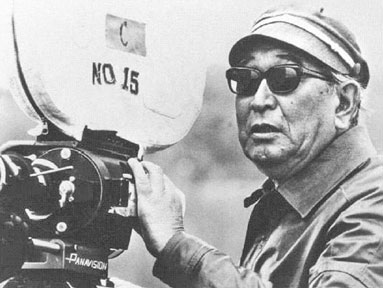The Kurosawa mark in the Japanese cinema
By Amal Hewavissenti
Akira Kurosawa's films became internationally acclaimed because of
his sensitivity and discipline in projecting a narrative through
cinematic pictures. He became a perfect model for subsequent film makers
simply because of his exclusive gift for infusing a real spirit into the
film by carefully selecting scenes, pictures and images that tell an
inexplicably poignant story.
Before Akira Kurosawa emerged a celebrated figure in cinema, he had
been a painter with a deep concern for people oppressed by the war. How
could a painter have revolutionised the Japanese cinema and most
probably the world cinema?
 |
|
Akira Kurosawa |
A newspaper advertisement of vacancies for assistant directors for a
cinema studio opened new dimensions in his life as a renowned painter in
Japan. Even-though his strong passion for painting had eclipsed any
liking within him for cinema, the new advertisement brought him the
chance of becoming an assistant director under “Shigeo Yano” a veteran
film-maker. Together, they directed “Shojohazonao”. Akira Kurosawa was
soon blessed with the opportunity to be the assistant director for
“Enoken nosenm anchoja” under Kajiro Kamamoto, and for “Tokyo Rhosody”
under Osama Fshimizu. After the setting up of Toho Film Company,
Kurosawa became the Chief Assistant Director for Kajiro Yamamoto who was
the managing director of Toho film company.
By 1940s, Kurosawa was deeply involved in writing film scripts and he
directed his first film “Saishiro” based on one of his own scripts.
Kurosawa's script writing is an interesting aspect in his career as a
film director. Wide reading on different aspects of cinema inspired his
imagination and the plight of people oppressed by the world war deeply
moved his spirit.
Kurosawa wrote tales based on the dismal tragedies of people affected
by the war and the most sensitive aspects of their lives. Young Kurosawa
was fortunate enough to work under different directors and to co-direct
films based on his scripts.
However, the fundamental theme of his scripts was on the sufferings
of people in the wake of the disastrous world wars and, this theme
appealed to Japanese audience. Kurosawa's own techniques and inventions
in arranging cinematic scenes and situations added a new dimension to
Japanese cinema which soon shaped itself into the mould of international
cinema.
Kurosawa's critics are of the view that he frequently underlined the
basic realities of life (though bitter) and his films under no
circumstances were meant to take the audience to “a Paradise” and to
make them oblivious to the real challenges of life.
He projects the basic theme of his films chiefly by the script, the
appearance of the actors, backgrounds, lighting, acting and editing.
However, he successfully exploits the potential of the film producer and
the camera to illustrate the ground realities. Kurosawa's skill in
composing scripts accelerated the pace of his success as a splendid film
director.
A painter
Akira Kurosawa's passion for painting is regarded as the primary
cause behind his advent on Japanese cinema. His ability for painting was
noticeable even in his early childhood. Kurosawa was engaged in studies
and research in a colleges of fire arts and presented numerous water
colour paintings and oil paintings for exhibitions and painting
competitions.
His painting Seybuthsu which reflects his intrinsic creativity and
skill in painting was ultimately chosen to be displayed at the painting
exhibition Nika. In whatever way, Kurosawa's sole expectation was to
make a living by selling paintings which illustrated the sheer
devastation brought about by the war. His paintings which reflected a
dissection of the plight of people oppressed by the war, achieved
massive popularity in Tokyo because of themes, colouring and
imagination.
His paintings that always deviated from the traditional framework of
Japanese painting, were greeted with an avalanche of publicity and
admiration. By a twist of fate, Kurosawa's enthusiasm for cinema
gradually eclipsed his earlier zeal and devotion for painting.
Akira Kurosawa earnestly believed that painting and reading
international literary classics unconditionally nourished a film-maker's
imagination and enabled him make creations of best quality. Kurosawa's
cinematic imagination was well nourished by the works of celebrated
artists such as Pablo Picasso, Leonardo da Vinci, Michaelangelo and
works by William Shakespeare, Alexander Pushkin, Dostuvuski, Leo Tolstoy
and Charles Dickens.
“Drunken Angel,” one of his earliest films is often cited as his best
film with highest cinematic elements. The film which centres round the
life in slums in Tokyo during the post-war period brought Akira Kurosawa
the highest popularity and success as a film director in Japan. His
masterpiece Rashomon earned him the Grand Prix Award at the Venice
Cinema Festival and practically brought to the international acclaim.
With the film, the world cinema began to focus more on attention on
Japanese cinema.
“Seven Samurai” one of his most popular films, speaks volumes for
Kurosawa's technical skill as a director and conveys the truth that war
earns no peace on earth. The film “Lkiru” is perhaps an cinematic epic
on humanity which noticeable contrasts from the general themes of his
films. The film portrays the tragedy en-shrouding the later half of the
life of a cancer patient.
Eventhough most of his films appeared alien to the average Japanese
cinema audience, the works were massively popular among the western
audience.
Seven Samurai (best loved by Hollywood film makers) was remade into
English under The Magnificent Seven. The Hidden Fortress, Derzu Uzala,
Dreams, Body Guard and I live in Fear underline his great potential as
one of the greatest figures in the world cinema.
The film Ran is perhaps the only film in Japanese Cinema history to
have been produced with a massive capital.
The film marked the climax of Kurosawa's forty year cinema career. He
breathed his last in the year 1998. |

